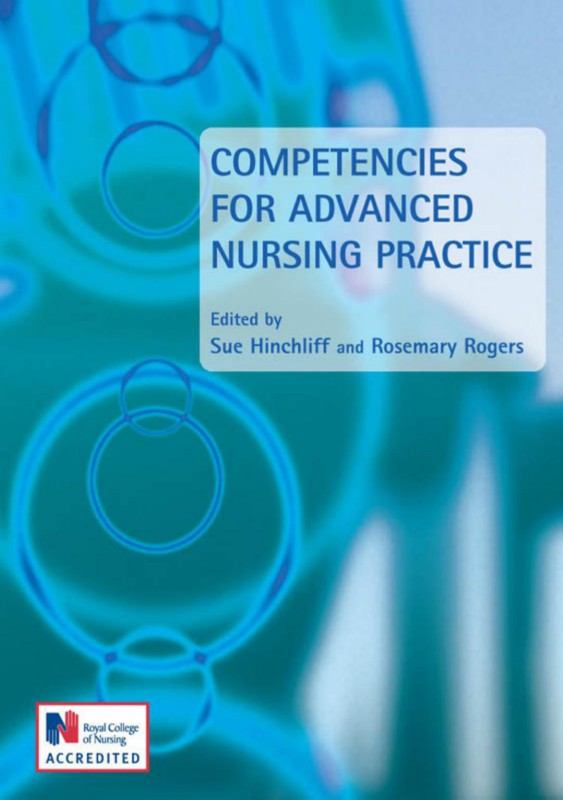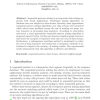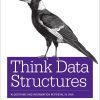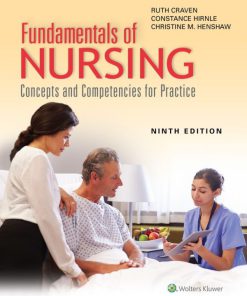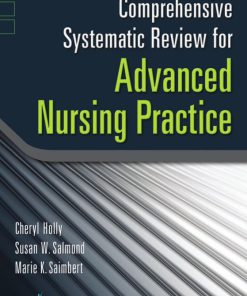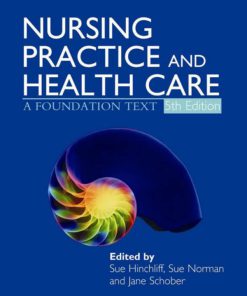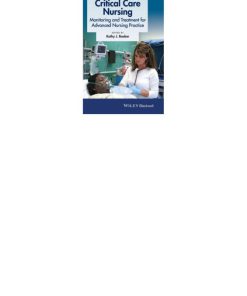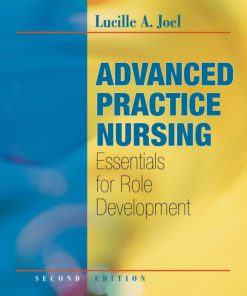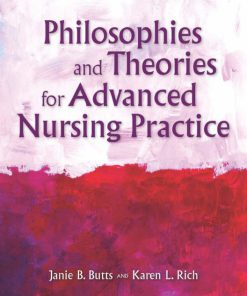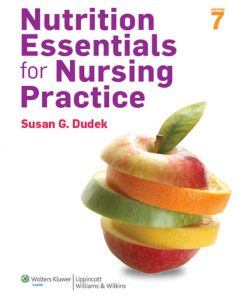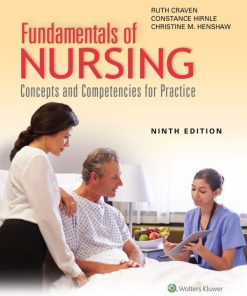Competencies for Advanced Nursing Practice 1st Edition by Susan Hinchliff, Rosemary Rogers 0340927682 9780340927687
$50.00 Original price was: $50.00.$25.00Current price is: $25.00.
Authors:Hinchliff, Susan M.; Rogers, Rosemary , Tags:9780340927687 , Author sort:Hinchliff, Susan M.; Rogers, Rosemary , Ids:9780340927687 , Published:Published:Aug 2010
Competencies for Advanced Nursing Practice 1st Edition by Susan Hinchliff, Rosemary Rogers – Ebook PDF Instant Download/Delivery. 0340927682, 9780340927687
Full download Competencies for Advanced Nursing Practice 1st Edition after payment
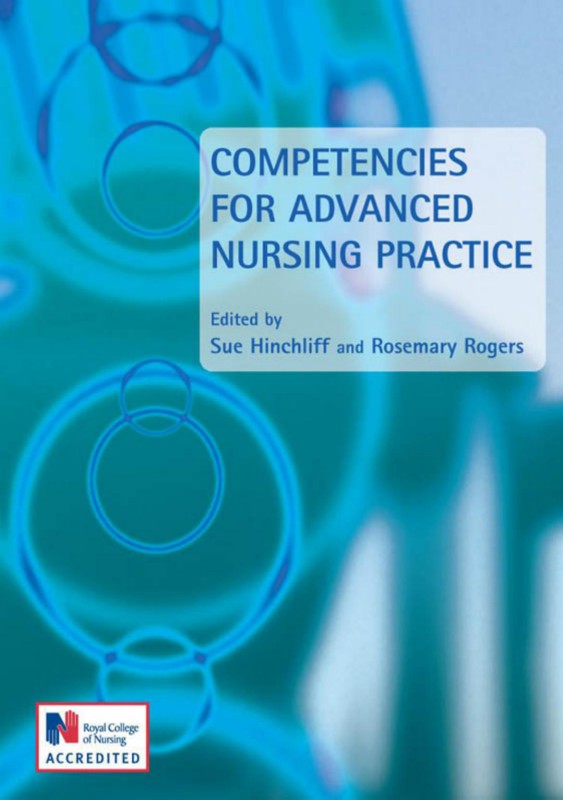
Product details:
ISBN 10: 0340927682
ISBN 13: 9780340927687
Author: Susan Hinchliff, Rosemary Rogers
Competencies for Advanced Nursing Practice is the first and definitive book to deliver guidance for practitioners working to be recognized for their advanced nursing practice. Written by experienced academics and advanced nurse practitioners from a variety of clinical backgrounds, this handbook will support nurses on their journey towards adv
Competencies for Advanced Nursing Practice 1st Table of contents:
1. What is Advanced Nursing Practice?
Introduction
Background
History and Development of Advanced Nurse Practitioner Roles
Defining the Practice of Advanced Nurse Practitioners
Educational Preparation of Advanced Nurse Practitioners
Future Issues
Conclusion
Acknowledgement
References
2. The Legal and Regulatory Implications of Advanced Nursing Practice
Introduction
The Regulatory Environments Applying to Clinical Practice
Civil law
Duty of care
Standard of the duty of care
Breach in the standard of care
Causation and harm
Reasonable forseeability
Connection between the negligent act and the alleged harm
Breach of duty of care but no causation
Defences
Criminal law
Employment law
Employer’s responsibility
Professional regulation
Advanced Nursing Practice
What’s in a name?
Higher standard of care
Bolam v. Friern Hmc[1958] (see Box 2.1 on p. 24)
Wilsher v. Essex Aha [1988] (see Box 2.2 on p. 24)
R. v. Adomako[1995] (Box 2.3)
Boundaries of the advanced nursing practice role
Initiated by the employing organization
Skill-matching
Setting the boundaries
Competent advanced nursing practice
Standard of care
Common and accepted practice
Evidence-based practice
Keeping up-to-date
Clinical supervision
Awareness of limits of competence
Whistleblowing
Entrepreneurial activities
Where the advanced practitioner is the employer
Personal indemnity
Vicarious liability for permanent employees (full-time or part-time)
Liability for practitioners who are not permanently employed
Additional insurance cover
Health and safety requirement for employers
Where the advanced practitioner is a partner in a practice
Common and accepted practice
Justification
Accountability
Confidentiality and access to health records
Leadership and responsibility
Leading the team
Delegation
Team liability
Consent
Consent and mental incapacity
The capacity principles
‘Best interests’ decision
Duty to consult
Conclusion
Cases
References
3. Domain 1: The Nurse–Patient Relationship
Introduction
Specific Competencies
Creates a climate of mutual trust and establishes partnerships with patients, carers and families
Validates and checks findings with patients
Creates a relationship with patients that acknowledges their strengths and knowledge and assists them in addressing their needs
Communicates a sense of ‘being there’ for the patient, carers and families and provides comfort and emotional support
Evaluates the impact of life transitions on the health/ illness status of patients and the impact of health/ illness on patients’ lives (individuals, families, carers and communities)
Applies principles of empowerment in promoting behaviour change
Preserves the patient’s control over decision-making, assesses the patient’s commitment to the jointly determined plan of care and fosters personal responsibility for health
Maintains confidentiality while recording data, plans and results in a manner that preserves the dignity and privacy of the patient
Monitors and reflects on own emotional response to interactions with patients’ carers and families and uses this knowledge to further therapeutic interaction
Considers the patient’s needs when bringing closure to the nurse–patient relationship and provides a safe transition to another care provider
Conclusion
References
Further Reading
4. Domain 2: Respecting Culture and Diversity
Introduction
Defining Culture, Ethnicity and Diversity
Culture
Ethnicity
Diversity
Legal and Ethical Considerations In Advanced Nursing Practice
Patient autonomy and choice
Related cultural competencies
Critical reflection
Feedback
Cultural Competence
Cultural awareness
Cultural knowledge
Cultural skills
Cultural encounter
Health
Concepts of health and illness experience
Ethnocentrism
The Health Belief Model and Explanation of Health Behaviours
Lay health beliefs
Explanatory models of illness
Related cultural competencies
Critical reflection
Related cultural competencies
Critical reflection
Feedback for Scenarios 4.2 and 4.3
Spiritual Competence
Related cultural competencies
Related spiritual competencies
Critical reflection
Feedback
Related cultural competencies
Related spiritual competencies
Critical reflection
Feedback
Definition of Spirituality and Religion and Meeting the Needs of Patients
Barriers to Achieving Cultural, Linguistic and Religious Competence
Critical reflection
Feedback
Cultural Linguistics
Related cultural competencies
Related spiritual competencies
Critical reflection
Feedback
Conclusion
Practical Steps In Achieving Domain 2: Cultural and Religious Competencies
Suggestions for achieving cultural and religious competencies
Tools for developing competencies
Eliminating Linguistic Barriers
Examples for achieving religious and spiritual competencies
References
Further Reading and Resources
5. Domain 3: Management of Patient Health/Illness Status
Introduction
Background
Collecting Evidence For Domain 3
Type of evidence
Diagnosis
Use of investigations
Patient expectations, beliefs and concerns
Clinical decision-making
Use of antibiotics
Self-care advice and treatment
Conclusion
Obtains, analyses and interprets history, presenting symptoms, physical findings and diagnostic information to develop the appropriate differential diagnoses
Diagnoses and manages acute and long-term conditions while attending to the patient’s response to the illness experience
Prioritizes health problems and intervenes appropriately, including initiation of effective emergency care
Employs appropriate diagnostic and therapeutic interventions and regimens with attention to safety, cost, invasiveness, simplicity, acceptability, adherence and efficacy
Formulates an action-plan based on scientific rationale, evidence-based standards of care, and practice guidelines
Provides guidance, counselling, advice and support regarding management of the health/illness condition
Demonstrates critical thinking and diagnostic reasoning skills in clinical decision-making
Analyses the data collected to determine the health status
Demonstrates knowledge of the pathophysiology of acute or chronic diseases or conditions commonly seen in practice
Applies theories and evidence-based practice pertinent to guide practice
Evaluates the use of complementary/alternative therapies used by patients for safety and potential interaction
Integrates appropriate non-drug-based treatment methods into a plan of management
Orders, may perform, and interprets common screening and diagnostic tests
Introduction
The prescribing dilemma
Reflection
Conclusion
Provides health promotion and disease-prevention services to patients who are healthy or who have acute and/or chronic conditions
Provides health education through anticipatory guidance and counselling to promote health, reduce risk factors, and prevent disease and disability
Develops and uses a follow-up system within the practice workplace to ensure that patients receive appropriate services
Employs appropriate diagnostic and therapeutic interventions and regimens with attention to safety, cost, invasiveness, simplicity, acceptability, adherence, and efficacy
Formulates an action plan based on scientific rationale, evidence-based standards of care, and practice guidelines
Provides guidance, counselling, advice and support regarding management of the health/illness condition
Demonstrates critical thinking and diagnostic reasoning skills in clinical decision-making
Formulates a problem list and prioritized management plan
Demonstrates knowledge of the pathophysiology of acute or chronic diseases or conditions commonly seen in practice
Applies principles of epidemiology and demography in clinical practice by recognizing populations at risk, patterns of disease, and effectiveness of prevention and intervention
Provides information and advice to patients and carers concerning drug regimens, side-effects and interaction, in an appropriate form
If legally authorized, prescribes medications based on efficacy, safety, and cost from the formulary
Schedules follow-up visits appropriately to monitor patients and evaluate health/illness care
Diagnoses and manages acute and long-term conditions while attending to the patient’s response to the illness experience
Prioritizes health problems and intervenes appropriately, including initiation of effective emergency care
Initiates appropriate and timely consultation and/or referral when the problem exceeds the nurse’s scope of practice and/or expertise
Assesses and intervenes to assist the patient in complex, urgent or emergency situations
Rapidly assesses the patient’s unstable and complex health care problems through synthesis and prioritization of historical and immediately derived data
Diagnoses unstable and complex health care problems using collaboration and consultation with the multiprofessional health care team as indicated by setting, speciality, and individual knowledge and experience
Obtains a comprehensive problem-focused health history from the patient or carer
Performs a comprehensive problem-focused, age-appropriate physical examination
Analyses the data collected to determine health status of the patient
Assesses, diagnoses, monitors, coordinates, and manages the health/illness status of patients during acute and enduring episodes
Communicates the patient’s health status using appropriate terminology, format and technology
Works collaboratively with other health professionals and agencies as appropriate
Recognizes environmental health problems affecting patients and provides health protection interventions that promote healthy environments for individuals, families and communities
Analyses and interprets history, presenting symptoms, physical findings, and diagnostic information to develop the appropriate differential diagnoses
Diagnoses and manages acute and long-term conditions while attending to the patient’s response to the illness experience
Prioritizes health problems and intervenes appropriately, including initiation of effective emergency care
Formulates an action plan based on scientific rationale, evidence-based standards of care, and practice guidelines
Provides guidance, counselling, advice and support regarding management of the health/illness condition
Initiates appropriate and timely consultation and/or referral when the problem exceeds the nurse’s scope of practice and/or expertise
Plans and implements diagnostic strategies and therapeutic interventions to help patients with unstable and complex health care problems regain stability and restore health, in collaboration with the patient and multiprofessional health care team
Rapidly and continuously evaluates the patient’s changing condition and response to therapeutic interventions and modifies the plan of care for optimal patient outcome
Obtains a comprehensive problem-focused health history from the patient or carer
Performs a comprehensive problem-focused, age-appropriate physical examination
Analyses the data collected to determine health status of the patient
Assesses, diagnoses, monitors, coordinates and manages the health/illness status of patients during acute and enduring episodes
Communicates the patient’s health status using appropriate terminology, format and technology
Uses community/public health assessment information in evaluating patient needs, initiating referrals, coordinating care and programme planning
Applies principles of evidence-based practice pertinent to their area of practice
Provides information and advice to patients and carers concerning drug regimens, side-effects and interaction, in an appropriate form
Orders, may perform, and interprets common screening and diagnostic tests
Evaluates results of interventions using accepted outcome criteria, revises the plan accordingly, and consults/refers when needed
Conclusion
References
6. Domain 4: The Education Function
Introduction
The Health of the Population
Perspectives From Policy
The expert patient: a new approach to chronic disease management for the 21st century
Choosing health: making healthy choices easier
Our health, our care, our say: a new direction for community services
The Developing Roles and Functions of the Nurse
Promoting Health: Models and Theoretical Perspectives
Introducing the Anp Students
Reflections on the Education Function of the Role
Practice, Policy, Theoretical Perspectives and Role Development
The expert patient
Choosing health
Red hat: my feelings
Black hat: negative side
Yellow hat: positive side
Green hat: application to practice
Blue hat: application to other situations
Our health, our care, our say
Reflections and Concluding Thoughts
References
7. Domain 5: Professional Role
Introduction
Develops and Implements the Advanced Nurse Practitioner Role
Uses evidence and research to implement the role
Functions in a variety of role dimensions: health care provider, coordinator, consultant, educator, coach, advocate, administrator, researcher, role model and leader
Interprets and markets the role to the public, legislators, policy makers and other health care professions
Directs Care
Prioritizes: coordinates and meets multiple needs for culturally diverse patients (see also Chapter 4)
Uses sound judgement in assessing conflicting priorities and needs
Builds and maintains a therapeutic team to provide optimum therapy
Obtains specialist and referral care for patients while remaining the primary care provider
Acts as an advocate for the patient to ensure health needs are met consistent with patient’s wishes
Consults with other health care providers and public/independent agencies
Incorporates current technology appropriately in care delivery
Uses information systems to support decision-making and to improve care
Provides Leadership
Is actively involved in a professional association
Evaluates implications of contemporary health policy on health care providers and consumers
Participates in legislative and policy-making activities that influence an advanced level of nursing practice and the health of communities
Advocates for access to quality, cost-effective health care
Evaluates the relationship between community/public health issues and social problems as they impact on the health care of patients (poverty, literacy, violence, etc.)
Actively engages in continuous professional development and maintains a suitable record of this development
Conclusion
References
Further Reading
8. Domain 6: Managing and Negotiating Health Care Delivery Systems
Introduction
The Anp: Managing and Negotiating Health Care Delivery
The Scenario and Analysis Structure
The portfolio evidence
‘Managing’ Health Care Delivery Systems
The management aspect
The management scenario analysis
The management portfolio of evidence
‘Negotiating’ Health Care Delivery Systems
Negotiating
The negotiating scenario analysis
The negotiation portfolio of evidence
Conclusion
References
Further Reading
Advanced practice: scope of practice, role development
Health policy and organizations
9. Domain 7: Monitoring and Ensuring the Quality of Health Care Practice
Introduction
Professional, Ethical and Legal Considerations
Incorporates professional/legal standards into advanced clinical practice
Acts ethically to meet the needs of the patient
Assumes accountability for practice and strives to attain the highest standards of practice
Evaluating Responses to Health Care and Revising Practice
Actively seeks and participates in peer review of own practice
Evaluates the patient’s response to the health care provided and the effectiveness of care
Interprets and uses the outcomes of care to revise care delivery strategies and improve the quality of care
Actively seeks and participates in peer review of own practice
Working Within the Health Care Team
Collaborates and/or consults with members of the health care team about variations in health outcomes
Evaluates patient follow-up and outcomes, including consultation and referral
Evidence-Based Practice
Promotes and uses an evidence-based approach to patient management that critically evaluates and applies research findings pertinent to patient care management and outcomes
Monitors current evidence-based literature in order to improve quality care
Continuing Professional Development
Accepts personal responsibility for professional development and the maintenance of professional competence and credential
Professional development for the organization
Professional development for the individual
The Anp’S Role In Maintaining His Or Her Own Professional Competence
Engages in clinical supervision and self-evaluation and uses this to improve care and practice
Actively seeks and participates in peer review of own practice
Accepts personal responsibility for professional development and the maintenance of professional competence and credential
The Anp’S Practice and Quality Improvement
Monitors quality of own practice and participates in continuous improvement
Research
Patient satisfaction
Audit trails
Feedback
Conclusion
References
10. Collecting the Evidence
Introduction
What is Accreditation?
Differences between academic and professional accreditation
Academic accreditation
Professional accreditation
Supporting the path to professional accreditation
The Benefits of Professional Accreditation
What is meant by evidence?
What constitutes evidence?
Critical incident reflections
Direct observation of practice
Notes of clinical supervision, facilitation
360° feedback
User perspectives: patient narratives, patient stories
Outcomes
Action learning
Other methods of collecting evidence
Writing your narrative
Capturing the Evidence
Professional portfolios
What to include in your portfolio
The evidence
Peer Review of the Evidence
Conclusion
References
Appendix 1: Mapping of the Nmc-Proposed Competencies Against the Knowledge and Skills Framework
Reference
Appendix 2: Nurse Practitioner Radiograph Referral Guidelines
Appendix 3: Portfolio Development
Portfolio Development
Reference
Appendix 4: Learning Contract Example
Example: Statement of Practice Competence
Appendix 5: Learning Contract Guide
Organization and Planning
People also search for Competencies for Advanced Nursing Practice 1st:
4 nursing competencies
qsen competencies nursing examples
8 competencies of a physician
seven core competencies of advanced practice nursing
You may also like…
eBook PDF
Nutrition Essentials for Nursing Practice 7th edition by Susan Dudek 1469832046 9781469832043

